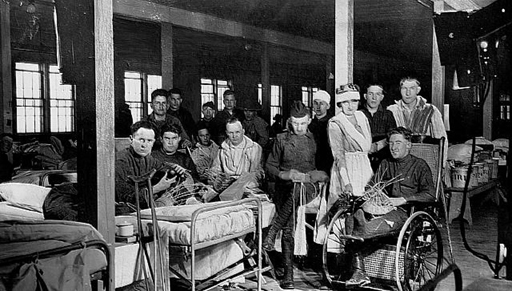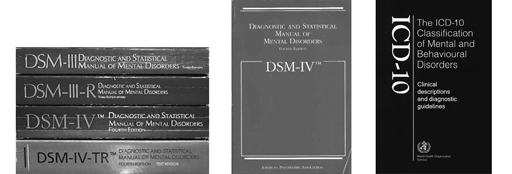2 Current western diagnostic systems and their history
Let’s now consider how these diagnostic labels came to be such an accepted part of our understanding. Diagnosis first emerged during the nineteenth century as part of the new medical specialism of psychiatry. At first, this focused narrowly on madness: ‘mania’, ‘dementia praecox’ (later to be dubbed ‘schizophrenia’) and ‘melancholia’ (now ‘depression’), as it was referred to when diagnosing wealthier patients, or ‘mopishness’ when diagnosing pauper lunatics.
The formalisation and elaboration of the sorts of diagnosis used today (as described below) is largely associated with the work of the German psychopathologist Emil Kraepelin. Kraepelin (1883) established three main axioms which became popularly understood (sometimes termed ‘medical naturalism’: Hoff, 1995):
- Mental disorders are genetically determined diseases of the nervous system.
- Mental disorders are separate, naturally occurring, categories.
- Mental disorders are fixed and deteriorating conditions.
Kraepelin depicted abnormal states in the way a botanist would classify plants. But this was not just about classification, because assumptions about genetic causation came with the descriptions. These assumptions brought with them, and justified, the need for medical control over patients. They also reflected and fed the eugenic ethos of the Victorian period. Eugenics refers to the betterment of human society or a particular racial group by increasing the birth rate of some groups and lowering it in others. It was assumed, simplistically, that physical and mental strengths and weaknesses were all, and always, inherited.
This social movement of eugenics was common across the political spectrum in Victorian times and arose largely because of the fear the middle classes had of the birth rate among the very poor. Because madness, idiocy, epilepsy, prostitution and criminality were more prevalent in this poorer group, eugenicists encouraged their control in a number of ways (including gender segregation in institutions: Pilgrim, 2008). The chronically poor were considered by eugenicists to be a product of a ‘tainted’ gene pool and were thus deemed to be responsible for ‘degeneracy’, and all the deviant behaviour that followed in its wake, if allowed to breed uncontrollably.
This eugenic–genetic emphasis on accounting for mental illness came into crisis, however, during the First World War, when many soldiers were hospitalised suffering from ‘shell shock’. The shell shock problem had two major implications for the development of psychiatric knowledge. First, ‘neurotic’ problems enlarged the jurisdiction of psychiatric interest, which had previously focused on ‘psychosis’ (experiences such as mania or delusions where people were seen as having ‘lost touch with reality’ in some way). Second, the core eugenic–genetic assumption of the late Victorian era was challenged. Those breaking down in the trenches of France and Belgium were ‘England’s finest blood’: officers and gentlemen, and working-class volunteers (Stone, 1985). In this context, the eugenic assumption of asylum psychiatry was tantamount to treason.

Today, assumptions about the genetic origins of mental illness still maintain a strong position in psychiatry. However, the enlarged classification system in the early twentieth century, to include the neuroses, personality disorders and substance misuse, meant that the primary role of biology was more ambiguous or even unlikely. Psychiatrists influenced by psychoanalysis developed a theory of neurosis that emphasised interpersonal and intra-psychic conflicts to account for mental abnormality. Also, behaviourist psychology began to provide its own environmentalist explanations for neurotic experience and conduct. Observations following those around shell shock continued to challenge simplistic genetic arguments. For example, the Wall Street Crash in 1929 showed that sudden shifts in social conditions could have rapid implications for the mental health of the population (Dohrenwend, 1998). What we now call ‘common mental health problems’ increased in frequency during this downturn in the economy. To take another example, when the concentration camps which housed the survivors of the Holocaust were opened at the end of the Second World War, this provided environmentalist insights into the profoundly disabling impact of ‘institutional neurosis’. Barely alive, skeletal figures paced up and down over and over, arms folded, and refused to move from their insanitary huts to newly fumigated and cleaned ones. The same behaviour could also be seen in psychiatric patients contained in the legacy of the Victorian asylums during the mid-twentieth century (Barton, 1958).
The above examples of changing views about environmentalist explanations for mental health problems have not diminished the enthusiasm for genetic explanations in psychiatry, but they have created healthy disputes within, and about, the profession. Consequently, even those who still retain a categorical approach to mental disorder are asked to suspend any assumptions about causation or ‘aetiology’. The current system – the Diagnostic and Statistical Manual of Mental Disorders (or DSM) – used by the American Psychiatric Association does not presume any knowledge of aetiology. Instead, it focuses on agreed symptom checklists as necessary and sufficient criteria for a particular label such as ‘depression’ or ‘anxiety’ (see the box for an example of the kinds of checklist used in the DSM). This more cautious approach to assumptions about the cause of mental health problems arose because within the APA biological and psychoanalytical psychiatrists had such opposing and irresolvable views about aetiology.

The WHO uses the International (statistical) Classification of Diseases and related health problems (ICD) system, which includes similar checklists to the DSM. Both the APA and the WHO endeavour to maintain consistency between their systems, but there are still some differences if you compare the two. In the UK practitioners in the National Health Service (NHS) tend to use the ICD (which covers all diseases, but has one chapter dedicated to ‘mental and behavioural disorders’), whilst counsellors, therapists and people in general are often more familiar with the DSM.
Box 1 Diagnosis of depression
To give an example of the kinds of checklist used in diagnosis, the DSM-IV criteria for ‘major depressive episode’ are as follows (APA, 1994, p. 356). A ‘major depressive disorder’ (p. 369) is diagnosed if a person has had two or more such episodes:
A. Five (or more) of the following symptoms have been present during the same two-week period and represent a change from previous functioning; at least one of the symptoms is either (1) depressed mood or (2) loss of interest or pleasure.
Note: Do not include symptoms that are clearly due to a general medical condition, or mood-incongruent delusions or hallucinations
- (1) Depressed mood most of the day, nearly every day, as indicated by either subjective report (e.g. feels sad or empty) or observation made by others (e.g. appears tearful). Note: In children and adolescents, can be irritable mood.
- (2) Markedly diminished interest or pleasure in all, or almost all, activities most of the day, nearly every day (as indicated by either subjective account or observation made by others).
- (3) Significant weight loss when not dieting or weight gain (e.g. a change of more than 5 per cent of body weight in a month), or decrease or increase in appetite nearly every day. Note: In children, consider failure to make expected weight gains.
- (4) Insomnia or hypersomnia nearly every day.
- (5) Psychomotor agitation or retardation nearly every day (observable by others, not merely subjective feelings of restlessness or being slowed down).
- (6) Fatigue or loss of energy nearly every day.
- (7) Feelings of worthlessness or excessive or inappropriate guilt (which may be delusional) nearly every day (not merely self-reproach or guilt about being sick).
- (8) Diminished ability to think or concentrate, or indecisiveness, nearly every day (either by subjective account or as observed by others).
- (9) Recurrent thoughts of death (not just fear of dying), recurrent suicidal ideation without a specific plan, or a suicide attempt or a specific plan for committing suicide.
B. The symptoms do not meet criteria for a mixed episode.
C. The symptoms cause clinically significant distress or impairment in social, occupational or other important areas of functioning.
D. The symptoms are not due to the direct physiological effects of a substance (e.g. a drug of abuse, a medication) or a general medical condition (e.g. hypothyroidism).
E. The symptoms are not better accounted for by bereavement, i.e., after the loss of a loved one, the symptoms persist for longer than two months or are characterized by marked functional impairment, morbid preoccupation with worthlessness, suicidal ideation, psychotic symptoms, or psychomotor retardation.
The DSM is readily available online and in libraries, so you might find it useful, at this point, to look up the other ‘mood’ and ‘anxiety’ disorders listed to see what the common diagnoses are for ‘fear’- and ‘sadness’-related problems.
Pause for reflection
Given this checklist, do you think that Mario’s GP was correct to diagnose him with depression?
Modern systems of classification based upon these kinds of behavioural criteria were consolidated in the late twentieth century. For example, Fish (1967) provided a basic psychiatric classification that still resonates in highly elaborated forms in more recent versions of the DSM and the ICD:
- Abnormal variations in mental life:
- abnormal intellectual endowments (‘learning disability’)
- abnormal personalities (‘personality disorders’)
- abnormal personality developments (for example, the emergence of pathological jealousy)
- abnormal reactions to experience (for example, ‘post-traumatic stress disorder’, neurotic distress, paranoid reactions).
- Mental illnesses:
- the functional psychoses (such as schizophrenia and bipolar disorder)
- organic states (such as toxic reactions, drug-induced psychosis and some forms of senile dementia).
